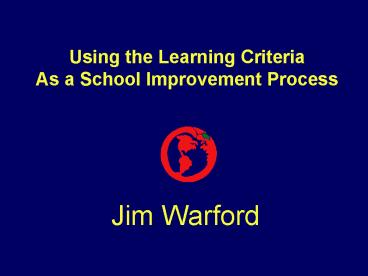Using the Learning Criteria As a School Improvement Process PowerPoint PPT Presentation
1 / 49
Title: Using the Learning Criteria As a School Improvement Process
1
Using the Learning Criteria As a School
Improvement Process
- Jim Warford
2
The Learning Criteria Is the next generation of
School Accountability And Continuous
Improvement
3
- Marion County
- 3 F schools
- 8 D schools
- A school
- 48 schools
- 58 Free and Reduced Lunch
- 34 minority
- Business Community up in arms!
4
In 1999, in Marion County, Florida we began
creating the Continuous Improvement Model
C.I.M.
5
PDCA Instructional Cycle
6
Marion CIM Results Went from three F eight D
and only one A school in 1999, to twenty A
sixteen B and no F schools by 2003 Moved
Marion from a low-performing district to an A
district and above state average for first
time Helped close the achievement gap between
student demographic groups
7
Reduced African-American students failing FCAT
from 50 to 30 Reduced Hispanic students
failing FCAT from 38 to 29 Cut the dropout
rate almost in half from 5.7 to 2.8
8
Results Documented in Educators in Action
Strategic Improvement Efforts Published
by American Productivity and Quality Center 2007
9
In 2003 I was Appointed Floridas First
Chancellor of Public Schools
10
And given responsibility For over 300 of
Floridas Lowest Performing Schools
11
- Between 2003-2006 the
- Continuous Improvement Model
- was implemented
- in over 300 of Floridas lowest-performing D and
F Schools - Through the
- Assistance Plus Program
12
- Within two years
- Over 80 of all
- Assistance Plus Schools
- Moved off Floridas low-performing list.
13
- Lessons Learned
- CIM raised the test scores for
- schools in crisis
14
What gets measured, gets done
15
What gets measured, gets done So be very
careful what you measure!
16
- Lessons Learned
- Greatest gains in elementary
- 4th Grade Data
- Dropout Rate not improving
17
- Lessons Learned
- Teaching to the Test
- Produces success on the test
- But
- Does it produce success in life?
18
- Lessons Learned
- We need an
- accountability tool
- that is more holistic
19
- Lessons Learned
- The Learning Criteria is the
- Next generation of accountability
- Because we believe
20
School success is measurable beyond the
state test! We need Multiple criteria to
measure learning
21
Sustainable Results
- In many cases, hard data is the total focus at
the exclusion of soft data in our systems. - This results in a short-term solution but a
long-term mistake!!!!!
22
Learning Criteria to Support 21st Century Learners
- Based upon
- Every school has its own unique DNA!
23
Learning Criteria to Support 21st Century Learners
- School success is measurable beyond the tests.
- Data must drive school improvement initiatives.
- Multiple criteria to measure student learning
- School growth and continuous improvement is an
ongoing, collaborative process.
24
Four Dimensions
- Core Academic Learning
- Achievement in the core subjects
- of English language arts, math and science and
others identified - by the school
25
- Stretch Learning
- Demonstration of rigorous and relevant
learning beyond the minimum requirements of the
state test
26
- Student Engagement
- The extent to which students are motivated and
committed to learning, have a sense of belonging
and accomplishment, and have relationships with
adults, peers, and parents that support learning
27
- Personal Skill Development
- Measures of personal, social,
- service, and leadership skills and demonstrations
of positive - behaviors and attitudes
28
Core
Stretch
Student Engagement
Personal Skill Development
29
Core
Dimensions of the Learning Criteria
Stretch
Student Engagement
Personal Skill Development
30
Measuring Student Learning
- Four Dimensions
- Core Academics
- Stretch Learning
- Student Engagement
- Personal Skills Development
31
"Without data you're just another person
with an opinion."
W. Edwards Deming
32
Core Academic Learning
- What is the core learning that your school will
stand behind for each and every student?
33
(No Transcript)
34
(No Transcript)
35
Stretch Learning
- How can your school insure that each and every
learner is being stretched?
36
(No Transcript)
37
(No Transcript)
38
(No Transcript)
39
Student Engagement
- How can schools know if their students are
motivated, committed and engaged in their
learning?
40
(No Transcript)
41
(No Transcript)
42
(No Transcript)
43
NATIONAL DATA
Delusional Discrepancies
I am proud of my school. T 81 S 47 I am
excited to be working with students. T
94 Teachers enjoy working with students. S
53 Students have fun at school. T 78 School is
boring. S 48 Students make school an exciting
place to work. T 88 Teachers make school an
exciting place to learn. S 27 I have fun at
school. T 83 Teachers have fun at school. S
36 Learning can be fun. T 99 S 64
44
NATIONAL DATA
A Crisis of Respect
I respect students. T 99 Teachers respect
students. S 51 Students respect me. T
86 Students respect teachers. S 36 Staff
respect each other. T 61 Students respect each
other. S 28
99
86
61
51
36
28
45
Personal Skill Development
- What evidence supports the development of
positive behaviors and attitudes, and how can
schools measure personal, social, service, and
leadership skills?
46
(No Transcript)
47
(No Transcript)
48
Learning Criteria Worksheets The Learning
Criteria Rubric
49
International Center for Leadership in Education,
Inc.
- Karen Wilkins
- 1587 Route 146
- Rexford, NY 12148
- Phone (518) 399-2776 x 206
- Fax (518) 399-7607
- E-mail Karen_at_Daggett.com
- Website www.LeaderEd.com
- PowerPoint - http//www.leadered.com/keynoterPP.s
html

